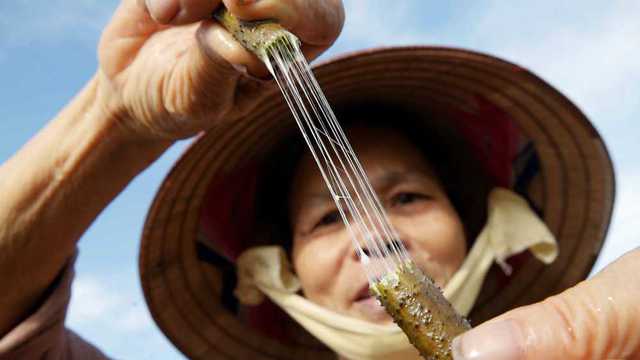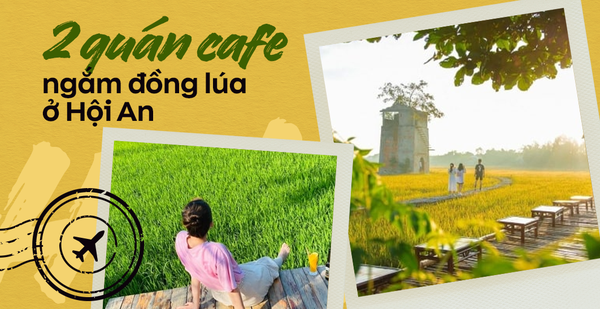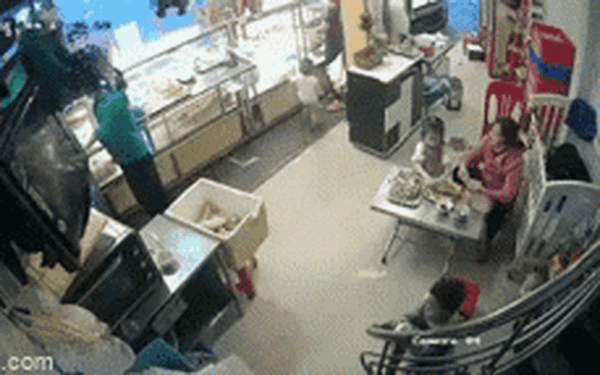Vietnam is one of only three countries that can produce it
The first Vietnamese artist
“In Vietnam, I am the first,” artisan Phan Thi Thuan proudly told AFP news agency about her journey to lotus silk – one of the rarest fabrics in the world that only Cambodia and Myanmar have. and more recently Vietnam, can produce.
Mrs. Thuan has been involved in weaving for 40 years, but silk from lotus silk is a completely different field. In 2017, Ms. Thuan just started researching and tinkering with different ways to find the technique to get the most silk from lotus stalks. It is not a simple process, requiring subtlety and meticulousness.
If in the traditional silk weaving industry, the silkworm is the main “worker” responsible for releasing the silk, in lotus silk, this is done by humans.
The artisan will use a small knife to cut the lotus stem, then gently separate it, pull out thin silk threads, skillfully hand-woven to braid them together. The lotus stem must be handled within 24 hours after being picked, because at this time, it still stores water, when pulling the silk will not break.

Artist Phan Thi Thuan pulls lotus silk. Photo: Business Insider
According to Mrs. Thuan, “the stalks of flowers in full bloom often give the most beautiful and firmest silk. When the lotus is too old, it is difficult to cut the stalk and draw the yarn. Lotus silk is softer and more elastic than silk”. After being braided, lotus silk is washed, dried and hand-woven.
Each lotus stem usually does not give much silk. Ms. Thuan estimates that a skilled worker can process 260 lotus stalks per day, creating 175m of yarn. It takes at least 1,500 lotus stalks to make a small lotus silk scarf. Large ones need several times more than that and can take up to 2 months for a finished product.
Such a laborious and time-consuming job, but Ms. Thuan thinks it’s well worth it. At first glance, lotus silk resembles both linen and coarse fabric; You can feel the fabric when you touch it. It’s soft to the touch, cool like linen, but doesn’t wrinkle easily and seems easy to clean if it gets dirty. A 25cm long lotus silk scarf has cost more than 200 USD.
A year after completing the first product, Ms. Thuan went to Cambodia to learn more about how to make lotus silk. She is confident that her silk is not inferior to products in a country with more experience.
Up to now, Mrs. Thuan’s workshop in Hoai Duc (Hanoi) has 20 workers – all of whom were taught by her, capable of making up to 20 towels each month. During peak busy times, the workshop can accommodate hundreds of people.
In addition to worrying about profit, Ms. Thuan considers maintaining and expanding the lotus silk-making model as her mission, because it “creates jobs and is good for the environment”. The female artist cherishes the desire to combine lotus silk and silk to create a fabric with lower production costs and more durable than pure lotus silk.
1 year survey has decided to make a big investment
Across the globe, Italian businessman Pier Luigi Loro Piana quickly trademarked Loro Piana Lotus Flower for luxury goods made from this fabric after seeing its potential.
The owner of high-end fashion brand Loro Piana knew about lotus silk fabric thanks to a gift from a Japanese friend. The donated beige cloth, along with the story of its birth, stimulated the curiosity of “industry people” – the sixth generation descendant of a family with a tradition in textiles. Placing the piece of fabric under a microscope, Loro Piana saw that the fibers looked very unusual, it had many microscopic “sponge-like” holes.
Loro Piana says he wears the lotus silk coat all year round, although it’s not as warm as the cashmere sweater. Through this experience, Loro Piana realized it was a great fit for the luxury line of natural fiber sportswear sold in her company’s couture chain, which stretches from Mandison Avenue in New York. York to Ginza in Tokyo.
Only 1 year after coming to Myamnar – the “hometown” of a precious gift from a Japanese friend, for a survey, in 2010, Loro Piana planned to sell high-quality towels and shirts from this fabric, and at the same time planned to imported lotus silk into Italy for industrial weaving and dyeing, instead of being handcrafted on a small scale. For him, the need for more workers to produce this precious fabric is not a problem. A lotus silk jacket made by Loro Piana’s company can start at around $5,600.
In Loro Piana’s perspective, the lotus silk jacket will be a highlight for her brand, highlighting innovation and creativity in textiles. He is optimistic that, “in the long run, it could turn out to be something very interesting”.
at Blogtuan.info – Source: cafebiz.vn – Read the original article here



